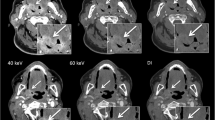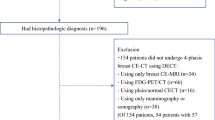Abstract
Objectives
To define optimal keV settings for advanced monoenergetic (Mono+) dual-energy computed tomography (DECT) in patients with head and neck squamous cell carcinoma (SCC).
Methods
DECT data of 44 patients (34 men, mean age 55.5 ± 16.0 years) with histopathologically confirmed SCC were reconstructed as 40, 55, 70 keV Mono + and M_0.3 (30 % 80 kV) linearly blended series. Attenuation of tumour, sternocleidomastoid muscle, internal jugular vein, submandibular gland, and noise were measured. Three radiologists with >3 years of experience subjectively assessed image quality, lesion delineation, image sharpness, and noise.
Results
The highest lesion attenuation was shown for 40 keV series (248.1 ± 94.1 HU), followed by 55 keV (150.2 ± 55.5 HU; P = 0.001). Contrast-to-noise ratio (CNR) at 40 keV (19.09 ± 13.84) was significantly superior to all other reconstructions (55 keV, 10.25 ± 9.11; 70 keV, 7.68 ± 6.31; M_0.3, 5.49 ± 3.28; all P < 0.005). Subjective image quality was highest for 55 keV images (4.53; κ = 0.38, P = 0.003), followed by 40 keV (4.14; κ = 0.43, P < 0.001) and 70 keV reconstructions (4.06; κ = 0.32, P = 0.005), all superior (P < 0.004) to linear blending M_0.3 (3.81; κ = 0.280, P = 0.056).
Conclusions
Mono + DECT at low keV levels significantly improves CNR and subjective image quality in patients with head and neck SCC, as tumour CNR peaks at 40 keV, and 55 keV images are preferred by observers.
Key Points
• Mono + DECT combines increased contrast with reduced image noise, unlike linearly blended images.
• Mono + DECT imaging allows for superior CNR and subjective image quality.
• Head and neck tumour contrast-to-noise ratio peaks at 40 keV.
• 55 keV images are preferred over all other series by observers.




Similar content being viewed by others
References
Sadick M, Schoenberg SO, Hoermann K, Sadick H (2012) Current oncologic concepts and emerging techniques for imaging of head and neck squamous cell cancer. GMS Curr Top Otorhinolaryngol Head Neck Surg 11:Doc08
Hermans R (2006) Staging of laryngeal and hypopharyngeal cancer: value of imaging studies. Eur Radiol 16:2386–2400
Tawfik AM, Kerl JM, Bauer RW et al (2012) Dual-energy CT of head and neck cancer: average weighting of low- and high-voltage acquisitions to improve lesion delineation and image quality-initial clinical experience. Invest Radiol 47:306–311
Toepker M, Czerny C, Ringl H et al (2014) Can dual-energy CT improve the assessment of tumor margins in oral cancer? Oral Oncol 50:221–227
Geets X, Daisne J-F, Arcangeli S et al (2005) Inter-observer variability in the delineation of pharyngo-laryngeal tumor, parotid glands and cervical spinal cord: comparison between CT-scan and MRI. Radiother Oncol 77:25–31
Vogl TJ, Schulz B, Bauer RW et al (2012) Dual-energy CT applications in head and neck imaging. AJR Am J Roentgenol 199:S34–S39
Tawfik AM, Kerl JM, Razek AA et al (2011) Image quality and radiation dose of dual-energy CT of the head and neck compared with a standard 120-kVp acquisition. AJNR Am J Neuroradiol 32:1994–1999
Paul J, Vogl TJ, Mbalisike EC (2014) Oncological applications of dual-energy computed tomography imaging. J Comput Assist Tomogr 38:834–842
Paul J, Mbalisike EC, Nour-Eldin N-EA, Vogl TJ (2013) Dual-source 128-slice MDCT neck: radiation dose and image quality estimation of three different protocols. Eur J Radiol 82:787–796
De Cecco CN, Darnell A, Rengo M et al (2012) Dual-energy CT: oncologic applications. AJR Am J Roentgenol 199:S98–S105
Simons D, Kachelriess M, Schlemmer H-P (2014) Recent developments of dual-energy CT in oncology. Eur Radiol 24:930–939
Bamberg F, Dierks A, Nikolaou K et al (2011) Metal artifact reduction by dual energy computed tomography using monoenergetic extrapolation. Eur Radiol 21:1424–1429
Stolzmann P, Winklhofer S, Schwendener N et al (2013) Monoenergetic computed tomography reconstructions reduce beam hardening artifacts from dental restorations. Forensic Sci Med Pathol 9:327–332
Schneider D, Apfaltrer P, Sudarski S et al (2014) Optimization of kiloelectron volt settings in cerebral and cervical dual-energy CT angiography determined with virtual monoenergetic imaging. Acad Radiol 21:431–436
Apfaltrer P, Sudarski S, Schneider D et al (2014) Value of monoenergetic low-kV dual energy CT datasets for improved image quality of CT pulmonary angiography. Eur J Radiol 83:322–328
Wichmann JL, Nöske E-M, Kraft J et al (2014) Virtual monoenergetic dual-energy computed tomography: optimization of kiloelectron volt settings in head and neck cancer. Invest Radiol 49:735–741
Grant KL, Flohr TG, Krauss B et al (2014) Assessment of an advanced image-based technique to calculate virtual monoenergetic computed tomographic images from a dual-energy examination to improve contrast-to-noise ratio in examinations using iodinated contrast media. Invest Radiol 49:586–592
Schabel C, Bongers M, Sedlmair M et al (2014) Assessment of the hepatic veins in poor contrast conditions using dual energy CT: evaluation of a novel monoenergetic extrapolation software algorithm. Röfo 186:591–597
Szucs-Farkas Z, Kurmann L, Strautz T et al (2008) Patient exposure and image quality of low-dose pulmonary computed tomography angiography: comparison of 100- and 80-kVp protocols. Invest Radiol 43:871–876
Cohen J (1960) A coefficient of agreement for nominal scales. Educ Psychol Meas 20:37–46
Delesalle M-A, Pontana F, Duhamel A et al (2013) Spectral optimization of chest CT angiography with reduced iodine load: experience in 80 patients evaluated with dual-source, dual-energy CT. Radiology 267:256–266
Marin D, Nelson RC, Samei E et al (2009) Hypervascular liver tumors: low tube voltage, high tube current multidetector CT during late hepatic arterial phase for detection–initial clinical experience. Radiology 251:771–779
Davenport MS, Khalatbari S, Cohan RH et al (2013) Contrast material-induced nephrotoxicity and intravenous low-osmolality iodinated contrast material: risk stratification by using estimated glomerular filtration rate. Radiology 268:719–728
Sudarski S, Apfaltrer P, Nance JW et al (2014) Objective and subjective image quality of liver parenchyma and hepatic metastases with virtual monoenergetic dual-source dual-energy CT reconstructions: an analysis in patients with gastrointestinal stromal tumor. Acad Radiol 21:514–522
Behrendt FF, Schmidt B, Plumhans C et al (2009) Image fusion in dual energy computed tomography: effect on contrast enhancement, signal-to-noise ratio and image quality in computed tomography angiography. Invest Radiol 44:1–6
Wichmann JL, Kraft J, Nöske E-M, et al (2014) Low-tube-voltage 80-kVp neck CT: evaluation of diagnostic accuracy and interobserver agreement. Am J Neuroradiol
Acknowledgements
The scientific guarantor of this publication is Dr Julian L. Wichmann. The authors of this manuscript declare relationships with the following companies: Ralf W. Bauer and J. Matthias Kerl are on the speakers' bureau of Siemens Healthcare, Computed Tomography division. The other authors of this manuscript declare no relationships with any companies, whose products or services may be related to the subject matter of the article. The authors state that this work has not received any funding. One of the authors has significant statistical expertise. Institutional review board approval was obtained.
Written informed consent was waived by the institutional review board. No study subjects or cohorts have been previously reported. Methodology: retrospective, case-control study, performed at one institution.
Author information
Authors and Affiliations
Corresponding author
Rights and permissions
About this article
Cite this article
Albrecht, M.H., Scholtz, JE., Kraft, J. et al. Assessment of an Advanced Monoenergetic Reconstruction Technique in Dual-Energy Computed Tomography of Head and Neck Cancer. Eur Radiol 25, 2493–2501 (2015). https://doi.org/10.1007/s00330-015-3627-1
Received:
Revised:
Accepted:
Published:
Issue Date:
DOI: https://doi.org/10.1007/s00330-015-3627-1




